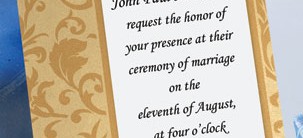With summer upon us, it’s time for employers to start thinking about motivational gifts for employees, and if you’re the
Continue readingMonth: June 2012

Types of Wedding Invitations-How About a Layered Invitation?
If you’re planning a do-it-yourself (DIY) wedding, your wedding invitation type, design and wording is probably one of the biggest,
Continue reading
Wedding Program Paper Options
Brides and grooms (or other family members) planning a do-it-yourself (DIY) wedding can add a special touch to the wedding
Continue reading